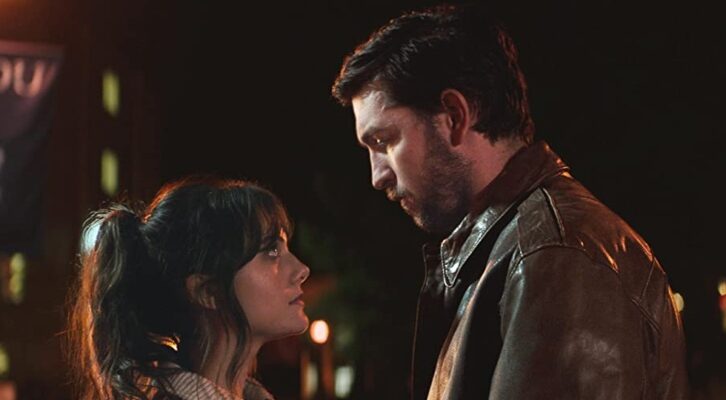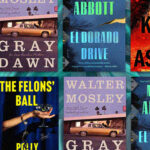
Kristen Roupenian and Susanna Fogel on Adapting “Cat Person” for Film
“The movie gets to make a lot of different choices—and has to, to be full and rich.”
This conversation took place at the 2nd annual Refocus Film Festival, a four-day celebration of the art of adaptation hosted by Iowa City’s nonprofit cinema, FilmScene.
Jane Keranen: Kristen, this was one that’s been on my mind for some time, since I first read the story. We were talking a little bit last night about how it came out when I was a freshman in college, and for freshmen girls in college, there was kind of a feral obsession to the story. I was curious about the genesis of the narrative, what you were trying to achieve, what feeling you were trying to convey, and whether you think the audience that received the story was the one you were writing to. Could you have even foreseen the alchemy of circumstances that led to this feral, cultish obsession with the story?
Kristen Roupenian: I will start with the easiest question first. No, I could not have foreseen anything about the reception of that story or the way it made its way into the world. Thank you. I think “a feral cultist obsession” is the best description. Now it’s all I ever want—I never want to write anything that isn’t received that way.
I was 35, I think, when I wrote the story. So I was older; I was not myself in college. But I was thinking a lot about what it was like for me to be 19, the way Margot is in the story. In my experience, as you age, you suddenly start looking back at your younger self as if you were a different person and you see like, oh, I was young. When I was 19, I thought I was just an adult. I was as old as I had ever been. I didn’t think I was going to get any older. I was like, I’m done. I’m cooked. And then when I got to be 35, suddenly all of these experiences I had had started coming back to me and looked much different. I was the age of Robert when I wrote the story. It took me to get to that age before I realized how young I was at that time, if that makes sense.
I wouldn’t say I wrote it with any particular outcome in mind, or even what I was trying to say. I always think, I said what I said, I don’t know what it was trying to say, but it all came out like that. But I do feel like that feeling of dread and ugh—that feeling was the thing I was trying to bottle, and I feel really grateful—and also sorry—that I managed to make a lot of other people feel that way. I feel very connected to the audience that responded with that kind of visceral intensity because that is where I wrote the story from.
Jane Keranen: Susanna, obviously you’ve cultivated here this beautiful, rich, layered cinematic landscape, and I was curious how you approached turning the short story into the film. Because so much of the short story is interiority, and we don’t necessarily see anything besides what’s going on in Margot’s head. You do implement that here through a lot of really excellent editing. And I was curious, what was it about the story that struck you as cinematic? What was the genesis of your realizing that this could be a film?
“Short of Kristen adapting it, I couldn’t think of a person who would be able to capture what was so incendiary about it and universal about it.”
Susanna Fogel: I should start by saying that I didn’t write the adaptation, so I have to credit Michelle Ashford with that piece of it. Obviously I read the story when it came out, I loved it, I engaged in all of the debates that other people were having around it. And just living in Los Angeles, I assumed someone would try to make it into a film. You just never assume that’s going to go well, ironically. Sometimes it does, as the movies at this festival show.
But this one, I wasn’t sure, because short of Kristen adapting it, I couldn’t think of a person who would be able to capture what was so incendiary about it and universal about it. I could picture somebody making it feel very small, and maybe just taking [Kristen’s] best language and putting it into a really invasive voiceover. I wasn’t sure how they were going to do it in a way that didn’t keep it feeling really small and internal, and that the reach the story had wouldn’t have that as a movie. Because if it was a small internal story about a woman, then men wouldn’t see it. The fact that the story was in The New Yorker I think thrust it in front of people who would maybe have dismissed the content in another medium, but because it was there, they had to reckon with it. And knowing how movies are, and how hard it is to get people to see movies about the female experience, or how niche those movies are considered, I just didn’t know how it would be able to have the breadth. I wasn’t sure the way forward really. I knew someone would try, but I wasn’t sure how.
But when I read Michelle’s script, she had taken the psychology and externalized it. Her idea was, I’m going to immerse the audience in this subjective experience that Margot’s having. They’re going to have invasive thoughts about getting strangled, they’re going to have to feel the fear that Margot feels, and those little cortisol fight or flight moments in Margot’s life that Kristen described so well are going to be felt by the audience. Michelle had that idea to make the audience, along with Margot, constantly wonder what genre of movie they’re in.
Which then, talking to Kristen more in these Q&As, I realized was consistent with what [she] also wanted to do. Or that feeling that being a young woman entails, which is like, what genre is my life? It’s a lot of them. I can be really scared one minute and actually fearing for my life, and then the next minute I can be being funny and sarcastic and flip. Michelle really wanted to create a multi-genre movie that is confusing and disjointed in how much it’s doing because that’s what the life of this young woman was. So that was the way we tried to approach it.
Jane Keranen: I am really fascinated by what you mentioned about how people wouldn’t necessarily be interested in seeing a movie that was just about a young woman’s experience. I do notice that something that is in the movie that isn’t necessarily in the story is a lot of Robert’s complexities, a lot of his interiority. He is a frightening man, but he is also more than that. He has his own complexities. I was curious about how you approached adding these complexities to both of the characters, making them both multidimensional. I know you mentioned in your Sundance Q&A how you wanted to explore grayer areas in who a character is and the situations in which they’re placed.
“The movie gets to make a lot of different choices—and has to, to be full and rich.”
Susanna Fogel: We talk about this a lot because in a short story, you are taking Margot’s and Kristen’s word for it. The observations she’s making that are leading you to picture something are fully in the control of the narrator. But when it comes to creating a visual, people are going to have to deal with a person they’re looking at. Everyone’s looking at the same person. And so that actor has to have a specific performance that’s going to make people think one way or another about him and his motivations. So just reckoning with a physical actor who’s standing there asking, why did I say that? Why did I do that? You have to construct dimension because you have to at least answer the question for him, to be able to inhabit the role.
And then in doing so, you end up talking about the interior life of this character, and psychoanalyzing dimensions of a character that maybe you didn’t want to have to delve that deeply into their psyche. And then you have to figure out, for that actor, what’s the context that led him to be this way. Without excusing the behavior, where did it come from, and how is he a product of his world? Even though he’s also complicit, too. All those conversations come up when there’s a man standing there saying, I have to justify being here and doing this. Even if they’re willing to be unlikable, which Nick [Braun] obviously was.
Jane Keranen: The last thing I was most curious about were the other embellishments in the adaptation that were not in the story. The dog, for example, in addition to Robert’s dimension. The well-meaning best friend who’s also Margot’s extreme opposite in a lot of ways. And of course, the ending.
Kristen, I’m not sure how much you were involved in the adaptation or if you had any say in what was changed in the story. And then, Susanna, I’m curious about what you wanted to achieve in the film and how you approach the adaptation process.
Kristen Roupenian: So the way the process worked was when they decided that they were going to make a film, basically the producers said, We’re going to do this. We’ll come back to you in a bit. And they went out and they hired Michelle Ashford, the screenwriter. She wrote a screenplay. I read it. And so, I was kept in the loop, but I wasn’t really a part of it. And I think that was necessary. I felt like I needed to take a step back. I didn’t have any kind of distance on the story at that point. It had been such a huge part of my life, at that point for more than a year. So, I had a lot of distance as the main parts were coming together.
And then when Susanna came on, I feel like that’s when I started seeing the texture, and we had a lot of text conversations and discussions about motivation. But it always felt like I was getting to watch something grow. I never really felt like I was adapting my story because I couldn’t have done it. It was a story in my head; I didn’t know how it would be a film. So, I got to watch that and see it evolve.
“I think any adaptation of any kind of interest is one that kind of says to the source material, We appreciate you, we respect you, now goodbye.”
And to me, still, I think the best way to read the story and watch the movie is to understand them as two very separate things. It’s funny you mention the dog. In the story, we don’t know if Robert has cats or not. That’s one of the things that Margot doesn’t get to know. In the movie, he has cats. And so you could watch the movie and be like, Oh, I read the story and now I know Robert has cats. But no, that’s not true. That’s not canon. You don’t know in the story if he has cats. The movie gets to make a lot of different choices—and has to, to be full and rich. I think that’s cool. I think any adaptation of any kind of interest is one that kind of says to the source material, We appreciate you, we respect you, now goodbye. We’re going to go do our other thing. That was my relationship to it. And I feel lucky that I got to be a part of it, and it came out so cool.
Susanna Fogel: By the time I came on to the project, Michelle had constructed a script that included that third act, so I understood what she was going for, and then it was a matter of working within that to make sure it felt like it was still going to hit the moments of resonance of Kristen’s story, and how it was doing that. So, in order to expand it into a movie that felt like a multi-genre thing, and like it was servicing the conventions of thriller films and all of that, it went from very personal story to big movie with devices that were inspired by the themes, but very allegorical and big, big, big. Fusing the two was what my job was. It was to kind of back into the relatability of the story and put that into what had become a bigger exoskeleton. That was a big part of it.
And the other thing we wanted to do is, in between Kristen’s story coming out and the movie getting made, there were a lot of movies that joined the canon of MeToo and post-MeToo. There were movies about revenge stories, about women and reckonings, and it felt like we had a lot of those movies. This wasn’t going to be one of the first movies of that type if that’s what we chose to do with it. But what it felt like we wanted more of was to question the gray areas, especially around things like consent, because the simplifying of that concept, or the extremeness with which it’s shown or was shown, oversimplifies a very complicated issue. I think this movie had an opportunity to show how much more complicated and messy those questions can be. We wanted to see situations that are a little more like life in that way, where it’s messy and complicated, and ideas of culpability and agency are really complicated, too.



















